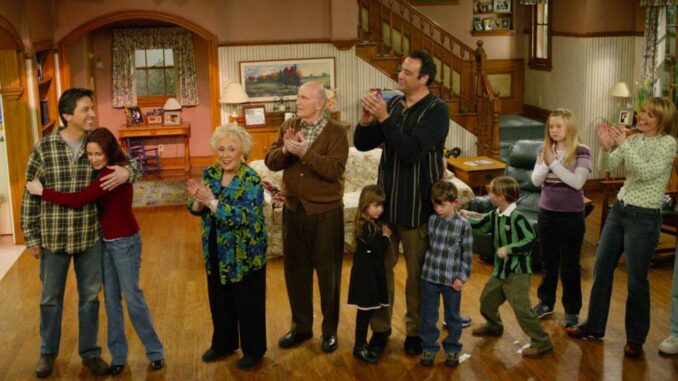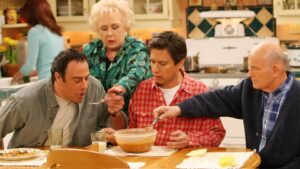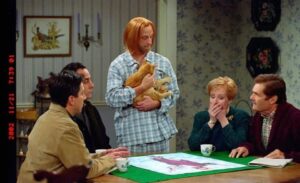
If you are a TV fan with an opinion on Everybody Loves Raymond, the classic family sitcom that ran on CBS from 1996 to 2005, then that opinion likely tilts a bit negative. (Though, let’s face it, the odds are good you don’t have any opinion whatsoever.) At a time when the TV comedy was increasingly embracing more cinematic forms and leaving the sound of live studio audience laughter behind, the stage-bound, audience laughter–enabled Raymond could feel a bit like a relic.

Its performances were broad, sometimes overly so. Its characters could seem spiteful for the sake of seeming spiteful. And it was set in that weird TV netherworld where every problem boils down to the same handful of characters fretting endlessly about it.
The most common refutation of Raymond’s charms ran something like this: “Oh, they’re always so angry and bitter toward each other. I hate that!” And from watching just an episode or two, it’s easy to see how one would arrive at that impression. This is a show, after all, with lots of yelling and shrieking, with characters chewing each other out for no real reason.
But as the show turns 20, I wanted to put in a defense of the program, which I legitimately love. Everybody Loves Raymond isn’t just the last gasp of a dying TV genre or a bitter swan song for the traditional family sitcom. No, it’s a legitimately great TV show — and one of the most psychologically astute programs ever made.
The marriage between Ray and Debra felt surprisingly fresh when the show debuted. CBS Photo Archive/Getty Images
One of the smartest things I’ve read about TV comedy writing came from Emmy-winning writer Ken Levine’s blog. (Levine is most famous for his work on M*A*S*H and Cheers, but his list of credits touches on dozens of critically beloved TV comedies.) Yes, funny situations are important, he said, but more important are funny, unique relationships.

This is why, say, the family sitcom never seems to run out of juice. For as many times as you see a husband and wife squaring off, or a mom and dad trying to wrangle their kids, or siblings screaming at each other, there are also a seemingly infinite number of permutations of those basic dynamics, simply because everybody who creates a family sitcom will have a slightly different take on how families operate, based on their own lives.
Raymond was created by series star Ray Romano and sitcom vet Phil Rosenthal, and the two drew much of their material from Romano’s standup comedy. As such, the relationships are crystal clear, even from the earliest episodes.
Ray’s wife Debra (Patricia Heaton) squabbles with him, sure, but the biggest source of their conflict is that his parents live right across the street, and he’s forever trapped between the roles of husband and son, sometimes within the same scene. Or take Ray’s relationship to his older brother, Robert (Brad Garrett), whose constant, burning envy of his younger sibling has curdled in adulthood into a psychological complex.
An outdated safety law may have cost hundreds of lives.There were a lot of shows that copied Raymond in hopes of getting a small sliver of its success, but they missed the specificity with which the series drew its relationships from the very first episode. They also missed the way those relationships kept the show’s focus laser-sharp.

2) Raymond started small — and stayed small
Everybody Loves Raymond
Even the series finale, pictured here, was a very small-scale story. CBS Photo Archive/Getty Images
Most modern sitcoms are constructed of an A-story, which takes up the bulk of the action, and then a B-story and C-story. (The amount of time they take up in the episode decreases the further down the alphabet you go.) The pinnacle of this approach was 2003’s Arrested Development, which spun nine different stories in nearly every episode — one for every member of the Bluth family.
But Romano and Rosenthal wanted to deliberately cut against the trend of splintering the story into smaller and smaller pieces, which was trendy at the time of Raymond’s launch, thanks to Seinfeld. So Raymond has no B- or C-stories. It just has the A-story, and all of the series’ characters weave in and out of that story over the course of an episode.
“We happened to have a show where the family, the entire cast, lives in close proximity to each other, and they can all relate to the A-story,” Rosenthal told me in an interview at June’s Austin TV Festival. “If a story is worth telling at all, we’re going to make it worth telling for the 22 minutes that we have. We don’t need to take time away to service characters in an almost obligatory or phony way. It weakens the episode.”
If the stories had huge dramatic stakes, that might feel forced. But the stories on Raymond are deliberately low-stake
